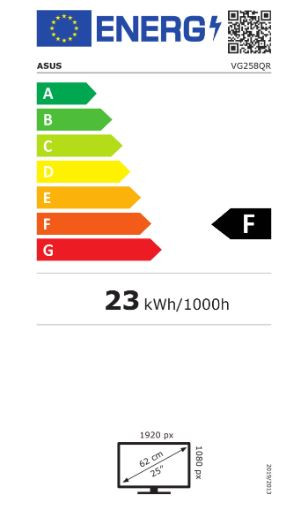



















£277.00*
- Resolution 1920 x 1080 Full HD
- Diagonal 25"
- Panel type TN
- Refresh Rate 165Hz



Product information
- 62.2cm (24.5 inches) 62.23cm (24.5 inches) Full HD gaming monitor with an ultra-fast 165Hz refresh rate and Adaptive Sync technology to prevent tearing as well as uneven frame rates
- 0,5ms* response time for smooth gameplay and ASUS Extreme Low Motion Blur (ELMB) technology to further reduce ghosting and motion blur
- Thanks to G-Sync Compatible certification, VRR (variable refresh rate) is automatically enabled to deliver absolutely smooth and flawless gameplay.
- Exclusive ASUS GamePlus hotkey for access to special gaming features and GameVisual for optimised image display
- Certified by TÜV Rheinland for Flicker-Free and Low-Blue-Light technologies, which offer a particularly comfortable viewing experience.
- Certified as G-SYNC compatible, FreeSync Premium technology delivers a seamless, tearing-free gaming experience as VRR (variable refresh rate) is enabled by default.
Designed for demanding and fast-paced gaming, the ASUS VG258QR is a 62.23cm (24.5-inch) full HD monitor with an ultra-fast response time of 0.5ms and a blazing fast 165Hz refresh rate for ultra-smooth gameplay. The VG258QR features Adaptive Sync(FreeSync™) technology to eliminate tearing and uneven frame rates.
Special gaming features, such as ASUS GamePlus, enhance your gaming experience. In addition, GameVisual provides various preset display modes to optimise graphics for different types of games.
Lightning fast 0.5ms
ASUS Extreme Low Motion Blur
The ASUS VG258QR is the fastest gaming monitor in its class, with a response time of just 0.5ms* to prevent streaking and motion blur. This allows you to react instantly to what's on screen, especially in fast-paced games - so you can take corners like a Formula 1 driver, or headshots like a seasoned pro.
In addition, the monitor features ASUS Low Motion Blur (ELBMB) technology, which provides sharper visuals of moving objects for smoother, more direct gameplay.
Exclusive ASUS GamePlus Technology
The ASUS VG258QR features the exclusive ASUS GamePlus hotkey, which allows gamers to access special gaming features to get more out of their game.
This feature is developed in collaboration with professional gamers to help them practice and improve their gaming skills.
Various connectivity options, slim bezel design
The ASUS VG258QR has extensive connectivity options, including dual-link DVI-D, DisplayPort 1.2 and HDMI (v1.4), so a wide range of multimedia devices can be connected. Thanks to the super-slim bezel with a width of only 1cm, it is particularly suitable for an impressive panoramic gaming scenario.
Flicker-Free Technology
Flicker-Free Technology reduces screen flicker to ensure a comfortable gaming experience. This prevents fatigue and other potentially eye-damaging conditions that can result from hours of gaming sessions in front of the screen.
Ergonomic design and wall-mounting option
The ASUS VG258QR gaming monitor is designed specifically for long gaming sessions. The ergonomic stand can be tilted, rotated and tilted as well as adjusted in height, allowing for an ideal viewing angle at all times. The monitor can also be mounted on the wall to save space.
Technical data
| Name | Asus VG258QR 25" TN Monitor, 1920 x 1080 Full HD, 165Hz, 1ms |
|---|---|
| Article number | 1000024545 |
| GTIN/EAN | 4718017122801 |
| Manufacturer SKU | 90LM0453-B01370 |
| EPREL ID | 407842 |
| Model name | VG258QR |
| Brand | Asus |
| Product Type | Monitor |
| Product Series | Asus VG Series |
| Technology | LCD |
| Panel type | TN |
| Resolution | 1920 x 1080 Full HD |
| Diagonal | 25" |
| Aspect Ratio | 16:9 |
| Viewing angle - Horizontal | 170° |
| Viewing angle - Vertical | 160° |
| Contrast Ratio | 1,200 :1 |
| Max. Brightness | 400 cd/m² |
| Response time | 1ms |
| Refresh Rate | 165Hz |
| Support - VESA | 100 x 100 |
| Inputs | 1x DVI-D , 1x Displayport , 1x HDMI |
| Features | Flicker Free , Integrated speaker |
| Product width | 56.25 cm |
| Product height | 32.89 cm |
| Product depth | 5.11 cm |
| Weight | 5.1 kg |
| Colour | Black |
| EEK Spectrum | A to G |
| Energy efficency class | E |
| Delivery contents | DVI cable , DisplayPort Cable , HDMI Cable , Power cable , Quick user guide , warranty card |
| Condition | New |
| Warranty | 24 Month |
| Warranty type | Bringin service Service and support information |
Downloads
Product safety
| Person responsible for the EU |
|---|
| Ninepoint GmbH |
| Im Mediapark 8 |
| 50670 Köln |
| Germany |
| info@asus-shop.de |



